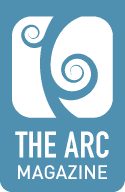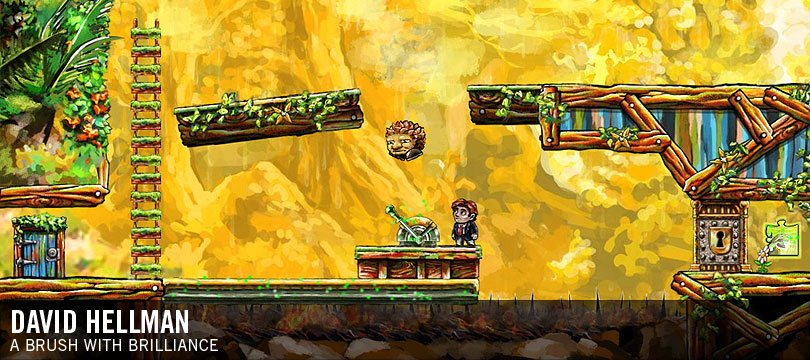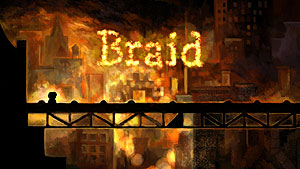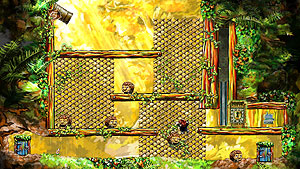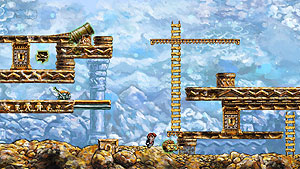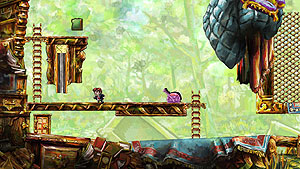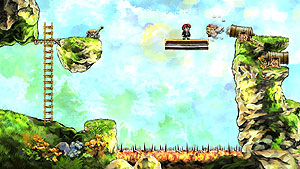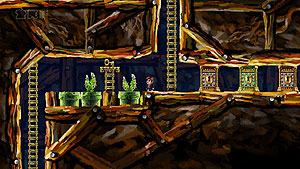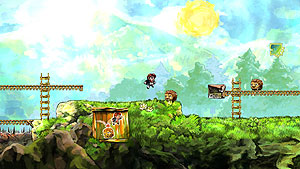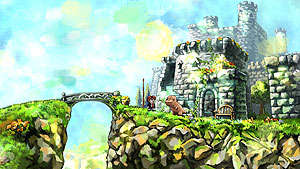
David Hellman
San Francisco artist David Hellman has worked on the web comic A Lesson Is Learned But The Damage Is Irreversible and more recently, created the artwork for the acclaimed 2009 XBox release, Braid. Keep tabs on his genius at www.davidhellman.net.
Click above to watch the Braid Trailer.
Q&A With Braid Artist, David Hellman
The Arc: David, how did you become involved in this amazing project?
David Hellman: My friend Eric-Jon Waugh, in his capacity as a reporter for Gamasutra, had seen the prototype demonstrated at GDC (Game Developers Conference). He inquired about it some time later and learned that Jon was looking for an artist. He got us in touch over email, and we started. Tracing the thread back further, I’d met Eric-Jon on a forum and he knew my art from the comics I’d been self-publishing. So you could attribute it to a modicum of creative initiative and internet socializing.
The Arc: Working alongside developer Jonathan Blow, you were the main artist involved in this game and were responsible for the style, user interface, visual storytelling, character animation and backgrounds - am I missing anything?
David Hellman: Edmund McMillen did the original character designs and animation cycles, which I painted over to match the world art, once that was setting the new visual tone. Edmund’s designs and animations remain very influential in the game. He’s credited for "animation prototyping." As for my own work, you didn’t mention the particle effects, which included background and foreground animation, and typical particle-y things like explosions, trailing smoke behind fireballs and fire. Of course, Jon wrote the particle system, but I specified how it would be used.
The Arc: what was it like to be at the creative visual "helm" of the game – were you in your element being given the opportunity to pour your creative ideas and artistic intuition around Jonathan’s framework?
David Hellman: Yes, because I’d just come from a project where I was drawing comics based on another man’s nonsensical ramblings. I’m just kidding when I characterize my collaborators that way. But Dale Beran’s comic scripts were pretty weird. He was the chaos to my order. He was a screaming child, throwing potato salad on the floor, and I was shaping it into art. In the case of Braid, Jon was like a potato farmer, and I was pesticide.
The Arc: What sort of things inspired you as you created the look, feel and textures for the world for Braid?
David Hellman: Primarily the story Jon had written, and playing the game itself. Artistically, Cézanne is always there to some degree.
The Arc: What tools did you use in creating the artwork for Braid?
David Hellman: I painted everything in Photoshop with a Wacom tablet. For those unfamiliar with it, a Wacom tablet is a slab of plastic that you move a stylus over, to move the cursor on screen. It’s far more sensitive and comfortable than drawing with a mouse. And it’s far more convenient and efficient than working with real-world materials (though less beautiful). The way I work is I always have my finger on the option key, which turns the brush tool into the eye-dropper, which is for grabbing color from somewhere on the canvas. So I’m always sampling colors from other parts of the image. When things start to get too averaged-out I go back to the palette for a pure color. In that way, I continuously push around the color shapes, kind of molding the picture, going over and over areas. I’m not a clean "pencil, ink, color, shade" kind of person. Recently I’ve started playing with Corel Painter, which produces much better textures than Photoshop.
The Arc: What were some of the biggest challenges you encountered while working on Braid?
David Hellman: There are a few challenges that I would rank about equally important and equally difficult. First, the art had to support and enhance the central artistic vision, to stand next to the puzzles, the prose, the music and the general feel of the interactivity as an equal partner. A lot of games slot neatly into a genre, so if you can do a sci-fi style, or a fantasy style, or a casual-friendly style, that’s enough. But Braid is a pretty idiosyncratic creation, so fitting in becomes a lot more subtle and interesting.
Second, the art had to communicate functionality. The best example of that is being clear about what’s foreground and what’s background. An artist will frequently be tempted to put something visually cool in a place that contradicts functionality, or draws attention towards an area that isn’t important to gameplay. But a harmonious marriage of functionality and visuals should be part of an artist’s aesthetic.
Third, I worked on Braid for two years, from home the whole time (or cafés). I learned a lot about self-motivating and managing my desire for my work to be amazing. etc. (I think that was something like, "you have to create something even though you want your work to be amazing.")
The Arc: Braid seems to resonate across the board. People are even motivated to create their own art and even music after being inspired by the game. Do you have any favorite Braid-inspired art pieces from fans that you can describe? How does it feel to be one of the creators behind something so inspiring?
David Hellman: Yeah, it was really cool when fan creations started popping up. I think the Soulja Boy video was my favorite, even though Mr. Boy distanced himself from his earlier comments when pressed by Stephen Totilo. From a valuing-creativity standpoint, I really liked the papercraft and the song by the XBox Boys. Some of the NeoGAF ads were pretty funny. The Action Button .net reinterpretation of Soulja Boy’s endorsement was probably the weirdest.
As for how it feels, it’s a lot of fun and I feel grateful to everyone who was moved by Braid. At the same time, I put up a little wall in my brain sometimes, because at the end of the day, it’s impossible to account for something like this, and I can’t go and make creative choices with expectations of popularity in mind. I do want my work to be life-changingly important to maybe a dozen people (no one in particular, though). In a different way, popular derision would also be affirming.
The Arc: You and Jonathan Blow appear to work really well together Do you prefer this type of tight collaboration compared to working with a larger team?
David Hellman: My experiences working creatively with larger teams have mostly been farcical. This is not really my opinion about all such projects, but personally I like small teams. Everyone has a lot of responsibility and a lot of impact. I also like dropping in and contributing to other people’s work as a kind of guest, but the best is when something’s your own, you want it to be great, and the team feeds off each other’s energies. It’s not all creative reasons, though; I also tend to avoid the politics involved in big groups or companies.
The Arc: Braid "means" different things to different people but as one of its creators, how would you describe the essence or value of the game?
David Hellman: That’s a hard question, but to answer it personally, maybe the essence is that it’s fairly non-mediated. It’s not contrived or faked or overly structured. When the game begins, you’re in the game. Almost everything that happens after that is a direct response to the player’s initiative — even if it’s just the initiative to walk to the right. There is no fanfare, no suspension of the action and nothing extraneous added to "break things up" or artificially delay the player’s natural (and helpful) tendency to get bored. The game is just a place operating by its rules, and by interacting with it, you can discover things.
The Arc: How did art and creativity shape your world as a child/youth?
David Hellman: I remember people watching me draw a face, and as soon as I’d draw one eye, they’d go "where’s the other eye?"
The Arc: Could you talk a little about how your creative process unfolds when you set to work on something?
David Hellman: If I’m joining an existing project, first I want to know everything about it. I want the complete context, and to really get a feel for the sensibility and values behind everything. Right now, though, I’m working on my own art (i.e. not a collaboration) for the first time in a while. While working on Braid, I stopped cultivating my own concepts as much as I’d done before. The Braid stuff was both fulfilling and tiring, so when I was done with that for the day, I would do something completely non-art-related. But right now I’m working up some ideas for a series of paintings. For me, one of the keys is keeping my sketchbook going. That’s where I cultivate ideas. Some of the pages are observational studies of things I see during the day, but most pages are small calligraphic compositional studies, diagrams or other kinds of notation. I just ordered some books off Amazon. I think I might need to do some writing next. I’m doing all these things to develop a context for myself, so when I set to work I won’t be repeating things I did five years ago.
The Arc: What are some of your other current interests and fascinations?
David Hellman: I’ve been watching all of David Attenborough’s documentaries on Netflix Streaming. The bizarreness and beauty of the world is something we learn young, but somehow forget to be amazed by. Seeing a humpback whale breaking the surface of the water with its jaws open at a terrifying angle brings one to question why we so often turn to fantasy or superstition to feel wonder. I’m also addicted to Ruby the swearing parrot on YouTube. I’ve started dividing up my friends according to who finds it funny. It’s not just the swearing, it’s her relationship with her owner, Nick. Really, it’s better than any sitcom. The series is called X Rated Parrot and there are about 150 videos. Next, I’m getting into maps.
The Arc: Who and what are some of the people and things that inspire you the most?
David Hellman: It’s been really inspiring to meet other artists who’ve chosen the challenges of independence, like Steph Thirion (Eliss) and Ron Carmel (World of Goo). The guys who used to do the 1UP Show, but got laid off like a lot of other people during the UGO buyout, went ahead and started their own company (Area 5) to keep doing what they love. Among non-people, I would point to the landscape of San Francisco.
The Arc: Parting thoughts on creativity, what it means to you?
David Hellman: Obligation, purpose, therapy, freedom, anxiety, competition, satisfaction, identity...
